
電気製品は、安全のための注意事項を守ら
ないと、人身への危害や火災などの財産へ
の損害を与えることがあります。
この取扱説明書には、事故を防ぐための重要な注意事項と製品
の取り扱いかたを示しています。この取扱説明書をよくお読
みの上、製品を安全にお使いください。お読みになったあとは、
いつでも見られる所に必ず保管してください。
この「取扱説明書」ではレンズの使いかたを説明し
ています。使用上のご注意など、レンズに共通した
ご注意や説明については別冊の「使用前のご注意」
でご覧頂けます。
必ずご使用の前に、本書と合わせてよくお読みのう
えでご使用ください。
本機はソニー製αカメラシステムEマウントカメラ専
用のレンズです。Aマウントカメラにはお使いになれ
ません。
35mm判相当の撮像素子範囲に対応しています。
35mm判相当の撮像素子搭載機種ではカメラ設定に
よってAPS-Cサイズでも撮影が可能です。
カメラの設定方法については、カメラの取扱説明書を
ご覧ください。
カメラ本体との互換情報については専用サポートサイ
トでご確認ください。
https://www.sony.jp/support/ichigan/
使用上のご注意
•レンズを絶対に太陽や強い光源に向けたままにしないで
ください。レンズの集光作用により、発煙や火災、ボディ・
レンズ内部の故障の原因になります。やむを得ず太陽光
下等におく場合は、前後レンズキャップを取り付けてく
ださい。
•逆光撮影時は、太陽を画角から充分にずらしてください。
太陽光がカメラ内部で焦点を結び、発煙や火災の原因と
なることがあります。また、太陽を画角からわずかに外し
ても発煙や火災の原因となることがあります。
•レンズを取り付けてカメラを持ち運ぶときは、カメラと
レンズの両方をしっかり持ってください。
•ズームにより繰り出されたレンズ部分でカメラを保持し
ないでください。
•本機は防じん、防滴性に配慮して設計されていますが、防
水性能は備えていません。雨中使用時などは、水滴がかか
らないようにしてください。
•レンズ単体の状態や、カメラ装着時に電源を切った状態
で本機を振ると、内部構造物が動き、音が発生することが
ありますが故障ではありません。
なお、本機を持ち運ぶ際などの振動で内部のレンズ群が
動いても、性能等に影響はありません。
フラッシュ使用時のご注意
•フラッシュ使用時には、1m以上離れて撮影してください。
•レンズとフラッシュの組み合わせによっては、レンズが
フラッシュ光を妨げ、写真の下部に影ができることがあ
ります。その場合は、焦点距離または撮影距離を調整して
撮影してください。
周辺光量について
•レンズは原理的に画面周辺部の光量が中心部に比べ低下
します。周辺光量の低下が気になる場合は、開放絞りから
1~2段絞り込んでご使用ください。
各部のなまえ
1 フォーカスリング
2 ズームリング
3 収納位置指標
4 焦点距離指標
5 レンズ信号接点*
6 焦点距離目盛
7 マウント標点
8 レンズマウントゴムリング
*直接手で触れないでください。
レンズの取り付けかた/取りはず
しかた
•レンズの取り付け/取りはずしは、レンズのマウント側
を持って行ってください。ズームリングやフォーカスリ
ングなどの操作部は持たないでください。
取り付けかた(イラスト
–
参照)
1
レンズリヤキャップとカメラのボディ
キャップをはずす。
2
レンズとカメラの白の点(マウント標点)を
合わせてはめ込み、レンズを軽くカメラに押
し当てながら、時計方向に「カチッ」とロック
がかかるまでゆっくり回す。
•レンズを取り付けるときは、カメラのレンズ取りは
ずしボタンを押さないでください。
•レンズを斜めに差し込まないでください。
3
レンズフロントキャップをはずす。
•レンズフロントキャップは図の(1)、(2)の2通りの
方法で取り付け/取りはずしができます。
取りはずしかた
1
レンズフロントキャップを取り付ける。
2
カメラのレンズ取りはずしボタンを押した
まま、レンズを反時計方向に回してはずす。
(イラスト
–
参照)
撮影準備
ズームリングを回して、焦点距離目盛の範囲(
)
が焦点距離指標に合うまでレンズを繰り出す。
レンズを収納するには(イラスト
–a参照)
ズームリングを回して、収納位置指標が焦点距離指標
に合うまでレンズを収納する。
ご注意
•焦点距離目盛
の範囲外では、正しく撮影することがで
きません。
•お使いのカメラによっては、焦点距離目盛の範囲外でも、
背面モニター/ファインダーに警告が表示されない場合
があります。
その場合は、以下のようになります。
‒絞り値がF14に固定されます。
‒フォーカスモードがマニュアルフォーカスに固定され
ますが、フォーカスリングによるピント合わせは行え
ません。
‒焦点距離目盛の範囲外で撮影された画像のExif情報で
は、レンズ名の末尾が「(Retract)」または「F0」になり
ます。
ズームする
ズームリングを回して、焦点距離目盛の範囲で
希望の焦点距離(ズームの位置)に合わせる。
ピントを合わせる
ピント合わせは、以下3つの設定方法があります。
•オートフォーカス
ピント合わせを自動で行う。
•DMF(ダイレクトマニュアルフォーカス)
オートフォーカスでピントを合わせた後に、マニュア
ルでピントを微調整する。
•マニュアルフォーカス
ピント合わせを手動で行う。
各モードの設定方法は、カメラの取扱説明書をご覧く
ださい。
主な仕様
商品名
(型名)
FE 28-60mm F4-5.6
(SEL2860)
焦点距離(mm)
28-60
焦点距離イメージ*
1
(mm)
42-90
レンズ群一枚
7-8
画角1*
2
75°-40°
画角2*
2
54°-27°
最短撮影距離*
3
(m)
0.3-0.45
最大撮影倍率(倍)
0.16
最小絞り
F22-F32
フィルター径(mm)
40.5
外形寸法(最大径×長さ)
(約:mm)
66.6 × 45
質量(約:g)
167
手ブレ補正機能 なし
*
1
撮像素子がAPS-Cサイズ相当のレンズ交換式デジタル
カメラ装着時の35mm判換算値を表します。
*
2
画角1は35mm判カメラ、画角2はAPS-Cサイズ相当の撮
像素子を搭載したレンズ交換式デジタルカメラでの値
を表します。
*
3
最短撮影距離とは、撮像素子面から被写体までの距離を
表します。
•レンズの機構によっては、撮影距離の変化に伴って焦点
距離が変化する場合があります。記載の焦点距離は撮影
距離が無限遠での定義です。
同梱物(()内の数字は個数)
レンズ(1)、レンズフロントキャップ(1)、
レンズリヤキャップ(1)、印刷物一式
仕様および外観は、改良のため予告なく変更すること
がありますが、ご了承ください。
はソニー株式会社の商標です。
This instruction manual explains how to use
lenses. Precautions common to all lenses such
as notes on use are found in the separate
“Precautions before using”. Be sure to read both
documents before using your lens.
This lens is designed for Sony α camera system
E-mount cameras. You cannot use it on A-mount
cameras.
The FE 28-60mm F4-5.6 is compatible with the
range of a 35mm format image sensor.
A camera equipped with a 35mm format image
sensor can also be set to shoot at APS-C size.
For details on how to set your camera, refer to its
instruction manual.
For further information on compatibility, visit the
web site of Sony in your area, or consult your dealer
of Sony or local authorized service facility of Sony.
For Customers in the U.S.A.
For question regarding your product or for the Sony
Service Center nearest you,
call 1-800-222-SONY (7669).
Supplier’s Declaration of Conformity
Trade Name : SONY
Model : SEL2860
Responsible Party : Sony Electronics Inc.
Address : 16535 Via Esprillo, San Diego, CA 92127
U.S.A.
Telephone Number : 858-942-2230
This device complies with part 15 of the FCC rules.
Operation is subject to the following two conditions:
(1) This device may not cause harmful interference,
and (2) this device must accept any interference
received, including interference that may cause
undesired operation.
Notes on Use
• Do not leave the lens exposed to the sun or a bright
light source. Internal malfunction of the camera body
and lens, smoke, or a fire may result due to the effect
of light focusing. If circumstances necessitate leaving
the lens in sunlight, be sure to attach the lens caps.
• When shooting against the sun, keep the sun
completely out of the angle of view. Otherwise, solar
rays may be concentrated at a focal point inside
the camera, causing smoke or a fire. Keeping the
sun slightly out of the angle of view may also cause
smoke or a fire.
• When carrying a camera with the lens attached,
always firmly hold both the camera and the lens.
• Do not hold by the part of the lens that protrudes
when zooming.
• This lens is not water-proof, although designed with
dust-proofness and splash-proofness in mind. If using
in the rain etc., keep water drops away from the lens.
• If the lens alone is shaken or if a camera with the lens
attached is shaken while the camera is turned off,
an internal component of the lens may rattle. This,
however, does not indicate a malfunction.
In addition, while you carry around the lens, your
movement may cause the internal lens groups to
shake. This, however, does not affect the performance
of the lens groups.
Precautions on using a flash
• When using a flash, shoot at least 1 m (3.3 feet) away
from your subject.
• With certain combinations of lens and flash, the lens
may partially block the light of the flash, resulting
in a shadow at the bottom of the picture. In such a
case, adjust the focal length or the shooting distance
before shooting.
Vignetting
• When using the lens, the corners of the screen
become darker than the center. To reduce this
phenomena (called vignetting), close the aperture by
1 to 2 stops.
Identifying the Parts
1 Focusing ring
2 Zooming ring
3 Lens retraction index
4 Focal-length index
5 Lens contacts*
6 Focal-length scale
7 Mounting index
8 Lens mount rubber ring
* Do not touch the lens contacts.
Attaching and Detaching the
Lens
• Before attaching/detaching the lens, hold the lens
by its mounting body. Do not hold it by any of its
operation controls, such as the zooming ring or the
focusing ring.
To attach the lens
(See illustration
–
.)
1 Remove the rear lens cap and the camera
body cap.
2 Align the white index on the lens barrel
with the white index on the camera
(mounting index), then insert the lens
into the camera mount and rotate it
clockwise until it locks.
• Do not press the lens release button on the
camera when mounting the lens.
• Do not mount the lens at an angle.
3 Remove the front lens cap.
• You can attach/detach the front lens cap in two
ways, (1) and (2).
To detach the lens
1 Attach the front lens cap.
2 While holding down the lens release
button on the camera, rotate the lens
counterclockwise until it stops, then
detach the lens. (See illustration
–
.)
Preparing for Camera Shooting
Rotate the zooming ring until the focal-
length index comes within the focal-length
scale range (
) to extend the lens.
To retract the lens
(See illustration
–a.)
Rotate the zooming ring until the lens retraction
index reaches the focal-length index to retract the
lens.
Notes
• When the focal-length index is located outside of the
focal-length scale range
, images may not be shot
correctly.
• Depending on the camera in use, no warning appears
on the rear monitor/finder even though the image is
shot when the focal-length index is located outside of
the focal-length scale range.
In such a case, the consequences are as follows:
– The aperture value is fixed at F14.
– The lens is kept in manual focus mode, but focusing
with the focusing ring is disabled.
– In the Exif information of the image shot when the
focal-length index is located outside of the focal-
length scale range, “(Retract)” or “F0” is appended
at the end of the lens name.
Zooming
Rotate the zooming ring to extend the
lens to the desired focal length (zooming
position) within the focal-length scale range.
Focusing
There are three ways to focus.
• Auto focus
The camera focuses automatically.
• DMF (Direct manual focus)
After the camera focuses in auto focus, you can
make a fine adjustment manually.
• Manual focus
You focus manually.
For details on mode settings, refer to the instruction
manual supplied with the camera.
Specifications
Product name
(Model name)
FE 28-60mm F4-5.6
(SEL2860)
Focal length (mm)
28-60
35mm equivalent
focal length*
1
(mm)
42-90
Lens groups-elements
7-8
Angle of view 1*
2
75°-40°
Angle of view 2*
2
54°-27°
Minimum focus*
3
(m (feet))
0.3-0.45 (0.99-1.48)
Maximum magnification (X)
0.16
Minimum aperture
f/22-f/32
Filter diameter (mm)
40.5
Dimensions (maximum
diameter × height)
(approx., mm (in.))
66.6 × 45
(2 5/8 × 1 13/16)
Mass (approx., g (oz))
167 (5.9)
SteadyShot
No
*
1
This is the equivalent focal length in 35mm format
when mounted on an Interchangeable Lens Digital
Camera equipped with an APS-C sized image sensor.
*
2
Angle of view 1 is the value for 35mm cameras, and
angle of view 2 is the value for Interchangeable Lens
Digital Cameras equipped with an APS-C sized image
sensor.
*
3
Minimum focus is the distance from the image
sensor to the subject.
• Depending on the lens mechanism, the focal length
may change with any change in shooting distance.
The focal lengths given above assume the lens is
focused at infinity.
Included items
(The number in parentheses indicates the number
of pieces.)
Lens (1), Front lens cap (1), Rear lens cap (1),
Set of printed documentation
Design and specifications are subject to change
without notice.
is a trademark of Sony Corporation.
Cette notice explique comment se servir des
objectifs. Les précautions communes à tous
les objectifs, par exemple les remarques sur
l’emploi, se trouvent sur la feuille « Précautions
avant toute utilisation ». Veuillez lire les deux
documents avant d’utiliser votre objectif.
Votre objectif est conçu pour les appareils photo à
monture E de type Sony α. Il ne peut pas être utilisé
pour les appareils photo à monture A.
Le FE 28-60mm F4-5.6 est compatible avec la plage
d’un capteur d’image de format 35 mm.
Un appareil photo équipé d’un capteur d’image de
format 35 mm peut être réglé pour la prise de vue
en APS-C.
Pour les détails sur la manière de régler l’appareil
photo, reportez-vous à son mode d’emploi.
Pour plus d’informations sur la compatibilité,
consultez le site de Sony de votre pays, ou
adressez-vous à un revendeur Sony ou à un service
après-vente agréé Sony.
Remarques sur l’emploi
• Ne laissez pas la lentille orientée vers le soleil ou une
source de lumière intense. Cela risque de provoquer
un problème de fonctionnement interne du boîtier
de l’appareil photo et de l’objectif, de dégager de la
fumée, voire de provoquer un incendie. Si toutefois
vous ne pouvez pas faire autrement, veillez à fixer les
capuchons sur l’objectif.
• Lors d’une prise de vue en direction du soleil, veillez
à ce que le soleil ne soit pas dans l’angle de vue.
Dans le cas contraire, les rayons solaires peuvent être
concentrés vers le point focal dans l’appareil photo,
et provoquer un incendie ou dégager de la fumée.
Vous pouvez provoquer un incendie ou dégager de la
fumée même si le soleil est légèrement en dehors de
l’angle de vue.
• Lorsque vous portez un appareil photo avec l’objectif
dessus, tenez toujours fermement l’appareil photo et
l’objectif.
• Ne tenez pas l’appareil photo par la partie de l’objectif
qui ressort lors d’un zoom.
• Cet objectif n’est pas étanche à l’eau bien qu’il
soit conçu pour résister à la poussière et aux
éclaboussures. Si vous l’utilisez sous la pluie, etc.
veillez à ce que de l’eau ne tombe pas dessus.
• Lorsque l'objectif seul est secoué ou lorsqu'un
appareil photo hors tension sur lequel est fixé
l'objectif est secoué, un composant interne de
l'objectif peut faire du bruit. Toufefois, ce phénomène
n’indique en aucune manière un dysfonctionnement.
En outre, lors du transport de l'objectif, votre
mouvement peut provoquer la vibration des groupes
de lentilles internes. Ceci n'influe toutefois pas sur les
performances des groupes de lentilles.
Précautions concernant l’emploi d’un flash
• Si vous utilisez un flash, prenez la photo à au moins
1m (3,3pi) du sujet.
• Associé à certains types de flash, l’objectif peut
bloquer partiellement la lumière du flash et produire
un ombre au bas de l’image. Dans ce cas, corrigez la
longueur focale ou la distance de prise de vue avant
la prise de vue.
Vignetage
• Lorsque l’objectif est utilisé, les coins de l’écran
deviennent plus sombres que le centre. Pour réduire
ce phénomène (appelé vignetage), fermez l’ouverture
de 1 ou 2 crans.
Identification des éléments
1 Bague de mise au point
2 Bague de zoom
3 Repère de repli de l'objectif
4 Repère de focale
5 Contacts d’objectif*
6 Échelle de focale
7 Repère de montage
8 Bague en caoutchouc de montage de l’objectif
* Ne touchez pas les contacts d’objectif.
Pose et dépose de l’objectif
• Avant de poser ou de déposer l'objectif, tenez-le
par sa monture. Ne le tenez pas par ses pièces de
fonctionnement, telles que la bague de zoom ou la
bague de mise au point.
Pour poser l’objectif
(Voir l’illustration
–
.)
1 Déposez le capuchon d'objectif arrière et
le capuchon de l'appareil photo.
2 Alignez le repère blanc du barillet
d’objectif sur le repère blanc de l’appareil
photo (repère de montage), puis posez
l’objectif sur la monture de l’appareil
photo et tournez-le dans le sens horaire
de sorte qu’il s’encliquette.
• N’appuyez pas sur le bouton de libération de
l’objectif sur l’appareil photo lorsque vous posez
l’objectif.
• Ne posez pas l’objectif de biais.
3 Retirez le capuchon d'objectif avant.
• Vous pouvez poser et déposer le capuchon
d’objectif avant de deux façons, (1) et (2).
Pour déposer l'objectif
1 Installez le capuchon d'objectif avant.
2 Tout en appuyant sur le bouton de
libération de l’objectif sur l’appareil
photo, tournez l’objectif dans le sens
antihoraire jusqu’à l’arrêt, puis déposez
l’objectif. (Voir l’illustration
–
.)
(Suite à la page arrière)
5-011-007-01(1)
SEL2860
交換レンズ
Interchangeable Lens
Objectif interchangeable
取扱説明書
Operating Instructions
Mode d’emploi
Manual de instrucciones
©2020 Sony Corporation
Printed in China
FE 28-60mm
F4-5.6
E-mount
–1
(1) (2)
a
6
–2
–3

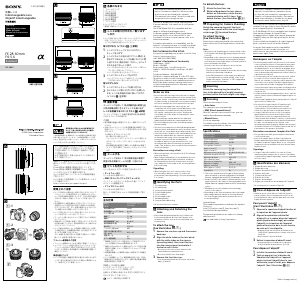


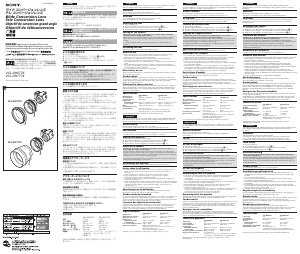

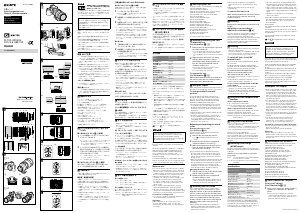
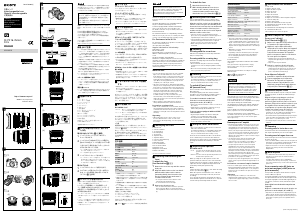
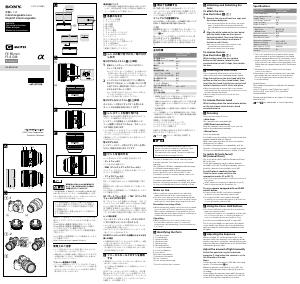
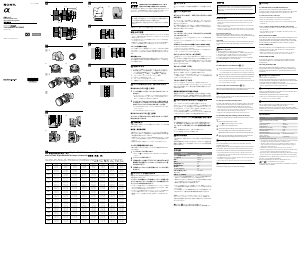
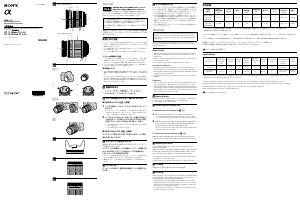
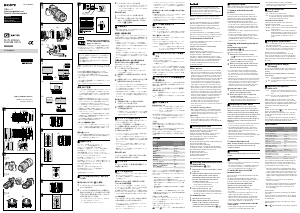
Únase a la conversación sobre este producto
Aquí puedes compartir lo que piensas sobre Sony SEL2860 Objetivo. Si tiene alguna pregunta, primero lea atentamente el manual. Puede solicitar un manual utilizando nuestro formulario de contacto.